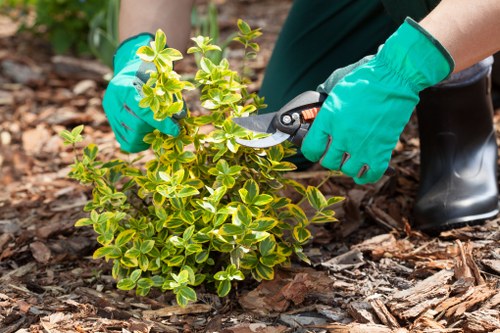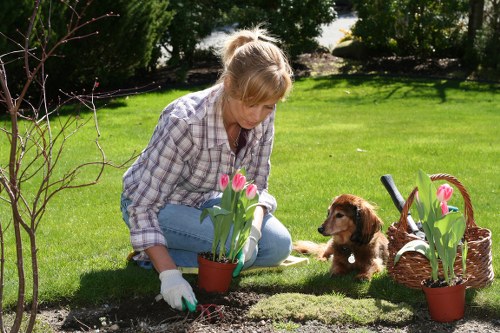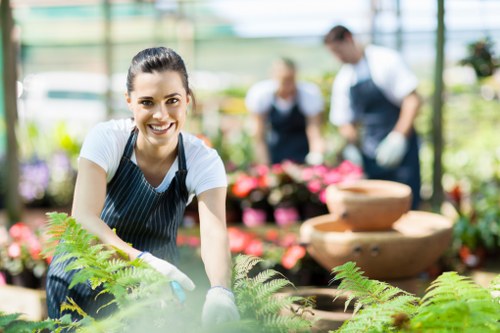Ultimate Guide to Garden Maintenance in Limehouse

Garden maintenance is crucial for keeping your outdoor space vibrant and enjoyable. In Limehouse, where the climate and urban setting present unique challenges, proper upkeep ensures your garden remains a sanctuary amidst the bustling city life.
Whether you’re a seasoned gardener or a novice, understanding the specific needs of Limehouse gardens can make all the difference. From soil health to plant selection, each aspect plays a vital role in the overall appearance and functionality of your garden.
In this comprehensive guide, we’ll explore the best practices for garden maintenance in Limehouse, helping you create and sustain a beautiful outdoor environment.
Understanding Limehouse’s Climate and Its Impact on Garden Maintenance

Limehouse experiences a temperate maritime climate, characterized by mild winters and warm summers. This climate influences the types of plants that thrive and the maintenance routines required to keep your garden in top shape.
**Temperature fluctuations** and seasonal changes affect plant growth cycles. By tailoring your maintenance practices to these variations, you can ensure your garden remains lush and healthy year-round.
Additionally, Limehouse’s urban environment means higher pollution levels and limited green spaces. Implementing effective garden maintenance strategies can mitigate these factors, promoting a healthier ecosystem in your immediate surroundings.
Choosing the Right Plants for Limehouse Gardens

Selecting plants that are well-suited to Limehouse’s climate is foundational to successful garden maintenance. Opt for species that are resilient to urban stressors such as pollution and limited soil quality.
Perennials like lavender and hostas are excellent choices, offering longevity and minimal maintenance. Additionally, incorporating native plants can enhance biodiversity and support local wildlife.
Consider incorporating a mix of flowering plants and greenery to create visual interest and ensure year-round appeal. This diversity not only enhances aesthetics but also contributes to a balanced and sustainable garden ecosystem.
Essential Garden Maintenance Tasks

Maintaining a garden involves various tasks, each contributing to the overall health and beauty of your outdoor space. Here are some essential garden maintenance activities tailored for Limehouse:
- Lawn Care: Regular mowing, aeration, and fertilization are key to a healthy lawn.
- Pruning and Trimming: Proper pruning promotes plant health and shapes your garden’s appearance.
- Weed Control: Keeping weeds at bay prevents them from competing with your desired plants for nutrients.
- Pest Management: Implementing eco-friendly pest control methods safeguards your plants without harming the environment.
- Soil Maintenance: Regularly testing and amending soil ensures optimal plant growth conditions.
By systematically addressing these tasks, you can maintain a vibrant and thriving garden throughout the year.
Seasonal Maintenance Tips

Seasonal changes require specific maintenance approaches to address the evolving needs of your garden. Here’s a breakdown of key maintenance activities for each season in Limehouse:
- Spring: Focus on planting new flowers, fertilizing the soil, and preparing beds for the growing season.
- Summer: Maintain consistent watering schedules, manage pests, and mulch to retain soil moisture.
- Autumn: Clear fallen leaves, prune dead branches, and plant bulbs for spring blooms.
- Winter: Protect sensitive plants, reduce watering, and plan for the upcoming gardening year.
Adapting your maintenance routine to the seasons ensures your garden remains resilient and beautiful despite climatic changes.
Effective Lawn Care Strategies
A well-maintained lawn serves as the foundation of a beautiful garden. Here are some strategies to keep your lawn in pristine condition:
- Regular Mowing: Mow your lawn at the appropriate height to promote healthy growth and prevent weed infestation.
- Fertilization: Apply fertilizers based on soil test results to provide essential nutrients.
- Aeration: Aerate the soil to improve oxygen flow and water absorption, enhancing root development.
- Overseeding: Introduce new grass seeds to fill in bare spots and improve lawn density.
Implementing these lawn care practices will ensure a lush, green, and resilient lawn year-round.
Pruning and Trimming for Plant Health
Pruning is essential for maintaining plant health, encouraging growth, and enhancing the aesthetic appeal of your garden. Here’s how to effectively prune and trim your plants:
- Identify the Right Time: Prune during the dormant season or after flowering, depending on the plant type.
- Use Proper Tools: Ensure your pruning tools are sharp and clean to make precise cuts and prevent disease transmission.
- Remove Dead or Diseased Branches: This promotes healthy growth and prevents the spread of pests and diseases.
- Shape Plants: Trim to encourage a desirable shape and size, enhancing the overall garden layout.
Consistent pruning and trimming not only improve plant health but also contribute to a well-organized and visually appealing garden space.
Eco-Friendly Pest Control Methods
Effective pest management is crucial for a healthy garden, but it’s equally important to adopt eco-friendly methods to protect the environment. Here are some sustainable pest control strategies for Limehouse gardens:
- Introduce Beneficial Insects: Encourage predators like ladybugs and praying mantises that naturally control pest populations.
- Use Organic Pesticides: Opt for natural remedies such as neem oil or insecticidal soap to manage pests without harmful chemicals.
- Implement Companion Planting: Grow plants that repel pests alongside your main crops to reduce infestation risks.
- Maintain Garden Cleanliness: Remove debris and fallen leaves to minimize hiding spots for pests.
Adopting these eco-friendly pest control methods ensures a healthy garden ecosystem while minimizing environmental impact.
Soil Health and Fertility
Healthy soil is the cornerstone of successful garden maintenance. Here’s how to maintain soil health and fertility in Limehouse gardens:
- Soil Testing: Conduct regular soil tests to determine pH levels and nutrient content.
- Amend the Soil: Add organic matter such as compost or manure to enhance soil structure and fertility.
- Mulching: Apply mulch to retain moisture, suppress weeds, and regulate soil temperature.
- Crop Rotation: Rotate plants to prevent soil depletion and reduce pest buildup.
By prioritizing soil health, you ensure that your plants receive the necessary nutrients for robust growth and resilience.
Watering Techniques for Optimal Plant Growth
Proper watering is essential for maintaining a healthy garden. Here are some effective watering techniques tailored for Limehouse’s climate:
- Deep Watering: Water deeply but infrequently to encourage deep root growth.
- Early Morning Watering: Water in the early morning to minimize evaporation and reduce the risk of fungal diseases.
- Use Drip Irrigation: Implement drip irrigation systems to deliver water directly to the plant roots, conserving water and reducing weed growth.
- Monitor Soil Moisture: Regularly check soil moisture levels to avoid overwatering or underwatering your plants.
Adopting these watering techniques promotes efficient water usage and ensures your garden thrives even during dry spells.
Mulching for Moisture Retention and Weed Suppression
Mulching is a crucial practice in garden maintenance, offering multiple benefits such as moisture retention, temperature regulation, and weed suppression. Here’s how to effectively mulch your Limehouse garden:
- Choose the Right Mulch: Select organic mulches like bark, straw, or compost, which decompose over time and enrich the soil.
- Apply Properly: Spread mulch evenly around plants, maintaining a layer of 2-3 inches to maximize benefits.
- Refresh Annually: Replenish mulch as needed to maintain its effectiveness and aesthetic appeal.
- Avoid Mulch Volcanoes: Keep mulch away from plant stems and trunks to prevent rot and pest issues.
Effective mulching enhances the health and appearance of your garden while reducing maintenance efforts.
Implementing Sustainable Garden Practices
Sustainability in garden maintenance not only benefits the environment but also creates a resilient and low-maintenance garden. Here are some sustainable practices for Limehouse gardens:
- Composting: Recycle garden waste and kitchen scraps into nutrient-rich compost to enhance soil fertility.
- Rainwater Harvesting: Collect rainwater for irrigation, reducing reliance on municipal water sources.
- Native Plant Selection: Choose native species that require less water and are more resistant to local pests.
- Integrated Pest Management: Combine biological, physical, and chemical methods to manage pests sustainably.
Incorporating these sustainable practices fosters a healthy garden ecosystem and minimizes environmental impact.
Utilizing Native Plants for Biodiversity
Native plants are well-adapted to Limehouse’s climate and soil conditions, making them an excellent choice for sustainable garden maintenance. Benefits of using native plants include:
- Water Efficiency: Native plants typically require less watering once established.
- Pest Resistance: They are naturally resistant to local pests and diseases.
- Support Local Wildlife: Native plants provide habitat and food sources for local butterflies, bees, and birds.
- Low Maintenance: These plants often require less care, reducing the time and effort needed for maintenance.
Incorporating native plants enhances the biodiversity of your garden and contributes to a balanced ecosystem.
Garden Tools and Equipment for Effective Maintenance
Having the right tools and equipment is essential for efficient garden maintenance. Here are some must-have tools for Limehouse gardeners:
- Pruning Shears: Ideal for precise cutting of branches and stems.
- Lawn Mower: Keeps your grass at an optimal height with ease.
- Garden Fork: Useful for aerating soil and turning compost.
- Hedge Trimmer: Essential for maintaining and shaping hedges and shrubs.
- Watering Can or Hose: Ensures consistent and effective watering of your plants.
Investing in quality garden tools enhances your maintenance efficiency and makes garden work more enjoyable.
Maintaining Garden Tools for Longevity
Proper maintenance of garden tools extends their lifespan and ensures optimal performance. Here are some tips to care for your tools:
- Clean After Use: Remove dirt and debris to prevent rust and corrosion.
- Sharpen Blades: Regularly sharpen blades to maintain cutting efficiency.
- Store Properly: Keep tools dry and store them in a sheltered area to protect from the elements.
- Oil Metal Parts: Apply oil to metal components to prevent rust and ensure smooth operation.
By maintaining your garden tools diligently, you ensure they remain reliable and effective throughout the gardening seasons.
Benefits of Regular Garden Maintenance
Regular garden maintenance offers numerous benefits, enhancing both the aesthetic and functional aspects of your outdoor space:
- Enhanced Curb Appeal: A well-maintained garden significantly boosts the visual appeal of your home.
- Increased Property Value: Attractive gardens can increase the market value of your property.
- Healthier Plants: Consistent care ensures plants thrive, reducing the risk of diseases and pests.
- Environmental Benefits: Healthy gardens contribute to better air quality and provide habitats for beneficial wildlife.
- Personal Well-being: Gardening can be a relaxing and rewarding activity, promoting mental and physical health.
Investing time and effort into regular garden maintenance reaps both immediate and long-term rewards.
Creating a Maintenance Schedule
Developing a structured maintenance schedule ensures that all necessary tasks are performed timely and efficiently. Here’s how to create an effective schedule for your Limehouse garden:
- Assess Your Garden’s Needs: Identify the specific requirements of your plants and garden layout.
- Plan Seasonal Tasks: Allocate tasks based on seasonal requirements, ensuring year-round care.
- Set Reminders: Use calendars or gardening apps to keep track of maintenance activities.
- Delegate Tasks: If possible, share maintenance responsibilities with family members or hire professional services for specialized tasks.
A well-planned maintenance schedule helps keep your garden organized and prevents tasks from being overlooked.
Hiring Professional Garden Maintenance Services in Limehouse
While DIY garden maintenance can be fulfilling, hiring professional services offers numerous advantages, especially in a dynamic urban area like Limehouse.
- Expertise and Experience: Professionals bring specialized knowledge and skills, ensuring high-quality maintenance.
- Time-Saving: Outsourcing maintenance frees up your time to enjoy your garden without the hassle of upkeep.
- Customized Services: Professionals can tailor their services to meet the specific needs of your garden.
- Access to Quality Equipment: Professional gardeners use advanced tools and equipment, enhancing the efficiency of maintenance tasks.
- Consistent Care: Regular professional visits ensure your garden receives consistent and thorough maintenance.
Considering the benefits, hiring professional garden maintenance services can significantly enhance the health and beauty of your Limehouse garden.
Choosing the Right Garden Maintenance Service
Selecting the right maintenance service involves several considerations to ensure you receive reliable and effective care for your garden:
- Reputation: Research reviews and testimonials to gauge the service’s reliability and quality.
- Services Offered: Ensure the company provides the specific services your garden requires.
- Experience: Choose services with experience in handling gardens similar to yours, particularly within Limehouse’s climate.
- Pricing: Compare pricing structures to find a service that fits your budget without compromising quality.
- Certifications and Insurance: Verify that the service providers are certified and insured, ensuring professional and safe operations.
Thorough research and evaluation help in selecting a garden maintenance service that aligns with your needs and expectations.
DIY vs. Professional Maintenance: Making the Right Choice
Deciding between DIY garden maintenance and hiring professionals depends on several factors, including your gardening skills, time availability, and the specific needs of your garden.
- DIY Maintenance: Ideal for those who enjoy gardening as a hobby and have the time to dedicate to regular upkeep. It offers greater control over maintenance activities and can be cost-effective.
- Professional Maintenance: Suitable for individuals with busy schedules or those seeking expert care for complex garden needs. Professionals ensure high-quality maintenance and can address issues promptly.
Evaluate your personal circumstances and garden requirements to make an informed decision that best suits your preferences and lifestyle.
Combining DIY and Professional Services
For many gardeners, a hybrid approach combines the best of both worlds. Here’s how you can effectively balance DIY efforts with professional services:
- Basic Maintenance: Handle routine tasks like watering, weeding, and minor pruning yourself to stay connected with your garden.
- Specialized Tasks: Delegate complex tasks such as landscaping, pest control, and major pruning to professionals.
- Seasonal Preparations: Hire experts for seasonal tasks like soil preparation and planting large beds, while managing smaller activities independently.
- Consultation: Use professional services for advice and planning, enhancing your DIY efforts with expert insights.
Combining DIY and professional services can optimize garden maintenance, balancing personal involvement with expert care.
Enhancing Your Garden’s Aesthetics
Aesthetics play a significant role in garden maintenance, transforming your outdoor space into a visually appealing sanctuary. Here are some tips to enhance your garden’s aesthetics:
- Plant Arrangement: Organize plants based on height, color, and blooming seasons to create a harmonious layout.
- Pathways and Hardscaping: Incorporate pathways, patios, and other hardscape elements to add structure and functionality.
- Ornamental Features: Add decorative elements like garden statues, fountains, or lighting to enhance visual interest.
- Color Coordination: Choose a color palette for your plants and accessories to create a cohesive and attractive garden theme.
- Seasonal Decorations: Update garden decor to reflect seasonal changes, keeping your garden fresh and engaging throughout the year.
By focusing on aesthetics, you can create a garden that not only thrives but also serves as a beautiful extension of your home.
Incorporating Sustainable Landscaping Elements
Sustainable landscaping integrates eco-friendly practices into your garden design, promoting environmental health and resilience. Here’s how to incorporate sustainable elements:
- Rain Gardens: Design rain gardens to manage stormwater runoff, reducing flooding and water pollution.
- Permeable Paving: Use permeable materials for pathways and patios to allow water infiltration and reduce runoff.
- Green Roofs and Walls: Implement green roofs or living walls to add greenery without taking up additional space.
- Composting Areas: Designate space for composting to recycle organic waste and enrich your soil.
- Solar Lighting: Utilize solar-powered lights to illuminate your garden sustainably.
Incorporating these sustainable landscaping elements enhances your garden’s environmental footprint and adds unique features to your outdoor space.
Conclusion: Achieving a Thriving Garden in Limehouse
Maintaining a beautiful garden in Limehouse requires a combination of knowledge, consistent effort, and strategic planning. By understanding the local climate, selecting appropriate plants, and implementing effective maintenance practices, you can create a thriving outdoor space that serves as a peaceful retreat and a proud display.
Whether you choose to undertake garden maintenance yourself or enlist professional services, the key is to stay informed and adaptable. Embrace sustainable practices, prioritize soil health, and focus on aesthetics to ensure your garden remains vibrant and resilient.
Ready to transform your Limehouse garden? Contact us today to book your garden maintenance service and take the first step towards a stunning and well-maintained outdoor sanctuary.